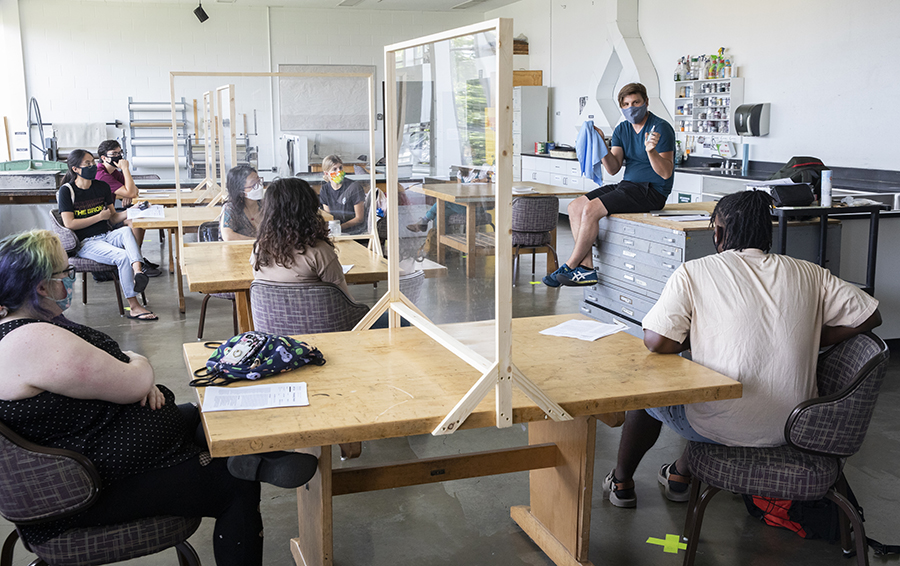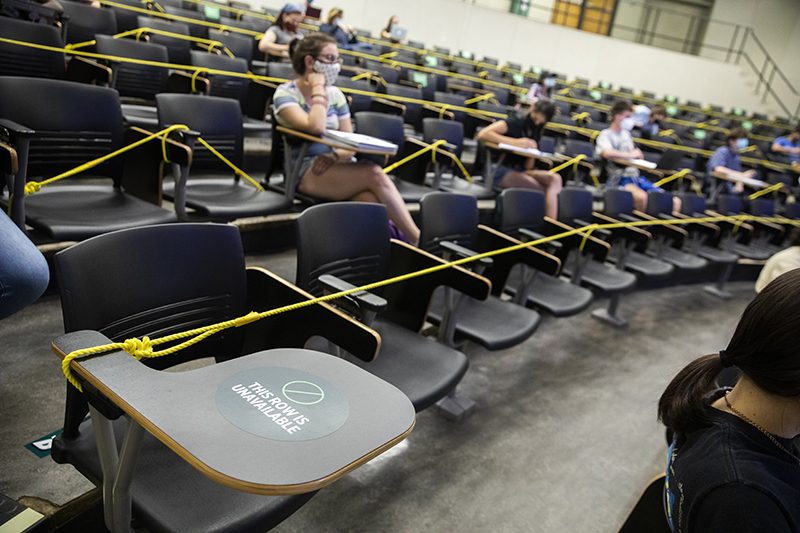Restarting Binghamton: The response to COVID
Plan helped safeguard campus community, enable University to meet academic mission

Ideas and feedback from hundreds of faculty, staff, students and administrators.
Guidance and support from New York state government and public health officials.
Input and assistance from Broome County, the City of Binghamton and municipalities.
It took Binghamton University more than three months of teamwork to develop and implement its Restarting Binghamton plan. The COVID-19 response plan, approved by the State University of New York on July 1, enabled students to receive onsite instruction and residential experiences on a campus that is safe for living and learning.
“More complex than the initial shift to remote learning in March, the overriding concern in developing the plan has been to protect the health and safety of our students, faculty and staff,” President Harvey Stenger said in a letter to the campus community. “The result is a detailed plan that lays out the process by which the University could, to the fullest extent possible, return to its educational, research and outreach missions.”
The principles of the plan are:
• Protect the health and safety of everyone associated with the University: students, faculty, staff and community members.
• Maximize the value of education by maintaining access for all students admitted to the University regardless of economic means, and maximize the success of all students to enhance their lives and futures.
• Sustain the research activities of the University to the greatest extent possible.
• Contribute to the economic recovery of the region.
In August, nearly five months to the day from when classes shifted online and most students were sent home for the spring semester, Binghamton University brought students and faculty back to campus.
THE CLASSES
The Restarting Binghamton plan provided students with more options for how they attend class.
“Our faculty did an exceptional job switching so quickly from in-person to online education this past semester,” says Donald Nieman, executive vice president for academic affairs and provost.
For students attending in person, there will never be a situation where there are more students than can be acceptable under social distancing guidelines. Most large lecture classes remain online-only.
“The whole part of Bingflex is that it is flexible,” says Andrea MacArgel, director of instructional design services for the University. “If, in the middle of the semester a student gets sick, that student can go online. Everything is flexible in that sense.”
The academic calendar was also tweaked, so students will not return to campus after the Thanksgiving break. Instead, classes will be held exclusively online from Nov. 30-Dec. 7, with an assessment period from Dec. 8-11.
THE COVID-19 TESTING
The University welcomed new students to campus with a week-long move-in period that required initial COVID-19 testing in the Events Center. More than 6,200 incoming students were tested between Aug. 19 and Aug. 25. Only 28 tested positive. Of those, the majority returned home to isolate, with four isolating on campus in a dedicated area and one isolating off campus.
David Hubeny, executive director of the University’s Office of Emergency Management, credits his team and campus volunteers for the testing success.
“Although nothing about a testing process as complex as this was easy, it was the volunteers and staff that made everything as easy as it possibly could have been,” he says. “They worked tirelessly to provide the highest level of professionalism and customer service that they possibly could. The volunteers and staff required very little oversight from managers because they were self-motivated and highly focused throughout each of the seven testing days.”
Surveillance testing then continued through the fall semester. The testing looks at samples of the campus population, rather than testing everyone, to try to identify problem areas or potential hot spots for spreading the virus. Students, faculty or staff members selected for testing are being notified 48 hours in advance and asked to register for a two-hour time slot that is convenient for them at Old Union Hall.
Updated test results can be found at the University’s COVID-19 dashboard at www.binghamton.edu/restarting-binghamton/covid-19-dashboard.html.
OTHER MEASURES
• Campus-community members must wear face coverings or masks that cover the nose and mouth at all times while in a Binghamton University or University-affiliated space. This includes all University buildings, grounds, classrooms, shared lab areas, conference rooms, restrooms, elevators, parking structures, etc. It doesn’t include instances when someone is alone in a private room, office or vehicle; cubicle space when appropriate social distancing can be maintained; in an isolated area with no other people in proximity; or when exercising outside when appropriate social distancing can be maintained.
• Binghamton University Dining Services changes include limited seating, serving all meals in carryout containers, vegan options, prepackaging meals to speed delivery and minimize wait times in lines, adding touchless payment processes and increasing sanitation in all facilities.
• The campus is not hosting in-person events that are open to the public during the fall semester. Co-curricular gatherings and meetings of student organizations occur only with appropriate social distancing (at least 6 feet of space between people) and will require participants to wear masks (unless outside and appropriately physically distanced). There will no plays, concerts, musical performances or film screenings with in-person audiences.”
• In July, the America East Conference postponed fall athletic competition through the end of the semester. Affected sports at Binghamton University are: men’s and women’s soccer; men’s and women’s cross country; volleyball; and golf.

